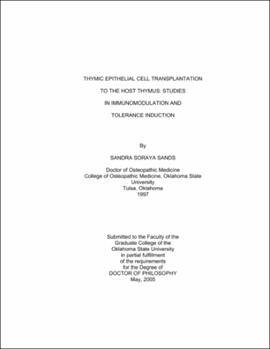| dc.contributor.advisor | Ketchum, Robert J. | |
| dc.contributor.author | Sands, Sandra Soraya | |
| dc.date.accessioned | 2013-11-26T08:22:59Z | |
| dc.date.available | 2013-11-26T08:22:59Z | |
| dc.date.issued | 2005-05 | |
| dc.identifier.uri | https://hdl.handle.net/11244/6675 | |
| dc.description.abstract | Scope and Method of Study: This study's purpose was to determine whether thymic epithelial cells (TECs) would work in a pre-transplantation intrathymic tolerance induction regimen, necessitating investigations on the establishment of a primary TEC line, characterization of the response of TECs to varying medium conditions, and investigation of immunologic effects of intrathymic TEC transplantation on the natural history of graft rejection in an allogeneic rat transplantation model. The efficacy of bone marrow has been established in a regimen of pre-transplant tolerance induction. It was hypothesized that isolated TECs might be better candidates. Primary tissue culture techniques were used to establish TECs from different rat strains. Light immunocytochemistry and transmission electron microscopy were used to evaluate the effects of varying medium conditions on cellular morphology and differentiation. Allotransplantation following intrathymic cellular inoculation with histological analysis of challenge grafts examined the tolerance inducing capacity of TECs. Multiple techniques tested the feasibility of gene therapeutic techniques on TECs. | |
| dc.description.abstract | Findings and Conclusions: Rat TECs were established from 4 different strains of inbred rats, one of which became a cell line. Light immunocytochemistry revealed cytokeratin intermediate filament expression, and electron microscopy revealed both cytokeratin intermediate filaments and desmosomes. Quantification of morphological changes revealed 1 desmosome per 6.24 �m of cell membrane in high calcium grown cells, and virtually no desmosomes in low calcium grown cells (p < 0.03). Intrathymic transplantation experiments revealed a reduction in graft mean lymphocytic infiltration from 1.78+0.47 in the negative control groups (intrathymic saline, IP saline; n=10) and 1.50+0.60 (intrathymic saline, IP ALS; n=8) to 0.25+.25 (p < 0.01) in the positive control group (intrathymic bone marrow + ALS; n=8), and a reduction in graft mean lymphocytic infiltration to 1.00+0.31 in the experimental group (intrathymic TEC, IP ALS; n=16), p value > 0.05. Overall, the results revealed that IT inoculation of TECs results in some immunomodulation, although not reaching the same effectiveness as bone marrow. This project served as the predecessor to a future project using genetically modified intrathymic TECs in a new paradigm for allogeneic tolerance induction. Initial transfection of TECs resulted in positive expression of reporter genes. | |
| dc.format | application/pdf | |
| dc.language | en_US | |
| dc.rights | Copyright is held by the author who has granted the Oklahoma State University Library the non-exclusive right to share this material in its institutional repository. Contact Digital Library Services at lib-dls@okstate.edu or 405-744-9161 for the permission policy on the use, reproduction or distribution of this material. | |
| dc.title | Thymic epithelial cell transplantation to the host thymus: Studies in immunomodulation and tolerance induction | |
| dc.contributor.committeeMember | Meek, William D. | |
| dc.contributor.committeeMember | Price, Joseph A., III | |
| dc.contributor.committeeMember | Watson, Gary H. | |
| dc.contributor.committeeMember | Ownby, Charlotte L. | |
| osu.filename | Sands_okstate_0664D_1279.pdf | |
| osu.accesstype | Open Access | |
| dc.type.genre | Dissertation | |
| dc.type.material | Text | |
| thesis.degree.discipline | Biomedical Sciences | |
| thesis.degree.grantor | Oklahoma State University | |
